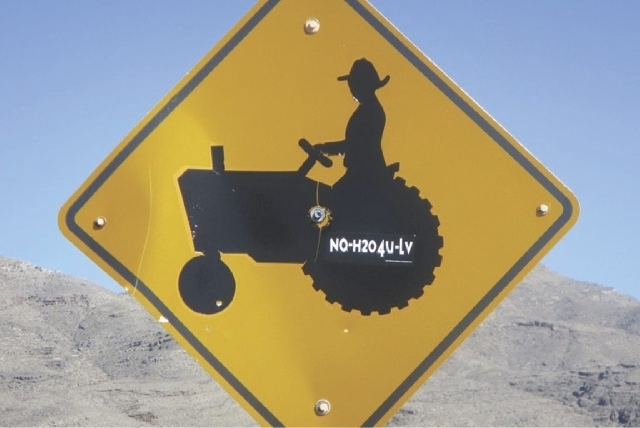Federal lawsuits seek to punch holes in $15 billion Las Vegas pipeline plan
A pair of federal lawsuits were filed Wednesday seeking to block the Southern Nevada Water Authority from siphoning groundwater across rural eastern Nevada.
A coalition including White Pine County, several American Indian tribes and a variety of groups in Nevada and Utah brought a wide-ranging, 75-page complaint accusing federal regulators of ignoring environmental laws and tribal trust obligations when they granted the authority permission to build more than 250 miles of water pipelines across public land.
The lawsuit was filed in Las Vegas federal court within hours of a similar suit from the national environmental group Center for Biological Diversity.
Both actions target the Bureau of Land Management and the U.S. Department of Interior, which granted the authority a right-of-way for its multibillion dollar pipeline project in December 2012.
“There’s been this abject failure on the part of the BLM and DOI … to look at the impacts of the project with any specificity or rigor,” said Simeon Herskovits, lawyer for the coalition that includes local government entities, tribes and other groups.
Federal officials also ignored their responsibilities to the Goshute, the Shoshone and other tribes by putting cultural sites at risk and cutting deals with the water authority without consulting tribal members, Herskovits said.
A spokeswoman for the BLM in Nevada said the agency does not comment on active litigation. “Hopefully when this is settled we’ll have more to say,” Erica Haspiel-Szlosek said.
The Center for Biological Diversity’s lawsuit specifically cites threats to rare species of fish, snails, frogs and toads — some of them already under federal protection — that would be wiped out if large-scale groundwater pumping by the authority dries out springs in rural Clark, Lincoln and White Pine counties.
The project also threatens to damage or fragment prime habitat for the greater sage grouse, a chicken-like bird now under consideration for endangered species status, according to the Tucson, Ariz.-based environmental group.
“Enough is enough,” said Rob Mrowka, spokesman for the group in Nevada, in a written statement. “Despite hundreds of pages detailing the unthinkable harm that would be caused by this project, tens of thousands of people signing petitions against it, and setbacks in state district and supreme courts, the Southern Nevada Water Authority and BLM have closed their ears to reason, logic and plain common sense. They need to drop this disastrous water grab.”
Water authority officials were weighing their options late Wednesday afternoon.
“These groups are, through a process authorized by federal law, testing the sufficiency of federal environmental investigations made under the National Environmental Policy Act by filing lawsuits,” said authority spokesman J.C. Davis in a written statement. “We will review the complaints during the next few weeks to determine our course of action.”
Las Vegas water managers first floated plans to tap rural groundwater in 1989. It is now being pushed as a way to supply future demand and provide a back-up supply to a community that relies on the overdrawn and drought-stricken Colorado River for 90 percent of its water.
The project is expected to reach as far north as Great Basin National Park, cost as much as $15 billion and take a decade or more to build.
Wednesday’s action likely marks the beginning of arguments, rulings and appeals in federal court that could drag on for years. Herskovits predicted it could take “at least a year” for their lawsuit just to make its way through federal district court.
The authority’s pipeline is also under attack in state court, where a district judge in December effectively stripped the project of its water rights and ordered further review by regulators.
Both the authority and the state engineer’s office are appealing that decision to the state Supreme Court.
Herskovits said there are similarities and some overlap between the two lawsuits, but the arguments raised by his clients are “more broad and far-reaching.”
“We expect our cases will be consolidated. Overall they fit together,” he said.
Since 2005, Herskovits has represented a diverse group of about 200 individuals and organizations united in their opposition to the pipeline project. The federal lawsuit was filed on behalf of a dozen different groups ranging from White Pine County to Utah’s League of Women Voters of Salt Lake.
Abby Johnson is president of the Great Basin Water Network, one of the plaintiffs in the suit filed by Herskovits Wednesday. She said the water authority is planning “the biggest groundwater pumping project ever built in the United States,” and she predicted it would have “devastating hydrological, biological and socioeconomic impacts across vast areas of eastern Nevada and Western Utah.”
In its lawsuit, meanwhile, the Center for Biological Diversity argues the BLM violated the National Environmental Policy Act and Federal Land Policy and Management Act when it gave the authority permission to sink wells and bury pipelines on federal land.
“These laws exist because Americans care about their public lands,” said Mrowka. “They exist so that the needs of future generations of Americans can be taken into account — not just short-term economic growth and greed.”
Contact reporter Henry Brean at hbrean@reviewjournal.com or 702-383-0350. Follow him on Twitter at @RefriedBrean.

















